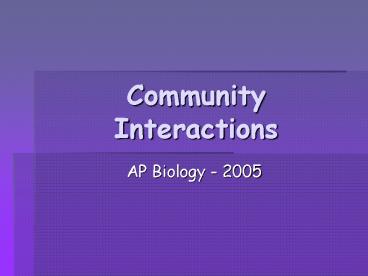Community Interactions - PowerPoint PPT Presentation
1 / 42
Title:
Community Interactions
Description:
Two species of barnacles live on North Atlantic seashores, but as adults, one ... The higher-zone barnacle outcompetes the other because it is more hardy when ... – PowerPoint PPT presentation
Number of Views:43
Avg rating:3.0/5.0
Title: Community Interactions
1
Community Interactions
- AP Biology - 2005
2
Community
- A division of an ecosystem that describes all of
the organisms that live in an area - Focuses on interactions within the community
- Establishes a niche a set of conditions under
which an organism exists
3
Interactions
- Focus on resources available in the community
- Food
- Water
- Space
- Mates
- Nesting sites
- Hiding places
- Light
- Macro and micronutrients
4
Limiting Resources
- There are only so many resources in a community
for all of the organisms - This limits the growth of populations of
organisms within this community - It leads to specialized interactions within the
members of this community - ( population dynamics)
5
Interactions
- Interspecific Between different species
- Intraspecific Within the same species
6
Interaction links and Examples
- http//eebweb.arizona.edu/Animal_Behavior/lycaenid
s/lycaen2.htm
7
Ecological relations( 1)
- One organism benefits in a relationship the other
is harmed or is eaten - Example predator prey and parasite host
- Rating /-
- Lynx and hare predator and prey
- Malaria, red blood cell, and human parasite and
hosts
8
(No Transcript)
9
(No Transcript)
10
(No Transcript)
11
Cyclic predator-prey relationships
12
Experiment
13
Experiment( con)
14
Ecological relations( 2)
- Two organisms compete for the same resources.
This is known as competition. - Rating -/- or /-
- Examples
- Competition for mates intraspecific
- Competition for space plants allelopathy
- Competition for nutrients and space fungi and
bacteria - antibiotics
15
(No Transcript)
16
(No Transcript)
17
Mutualism
- Both organisms benefit
- Rating /
- Zooxanthellae and coral polyp
- Legumes and Rhizobium
- Leaf cutter ant and fungal garden
- Ant and acacia
18
(No Transcript)
19
Leaf cutter ants and fungal gardenshttp//www.blu
eboard.com/leafcutters/what.htm
http//cas.bellarmine.edu/tietjen/Ecology/fungus.h
tm
20
Ant and the Acacia
21
Commensalism
- One organism benefits the other is neither
harmed or benefits - /0
- Examples Pinnepidia crab and tube worm
22
Amensalism
- Animals can have a negative effect on the
environment - 0/-
- Animals trampling the grass on the way to the
water hole
23
Contradictions
- Not all organisms fit the description exactly
- The definition for symbiosis is changing to
include only those interactions between organisms
of two different species whose metabolism is
altered by the interaction
24
Competition- Interspecific
- Allelopathy How plants guard their space by
releasing molecules into the environment that
deters other plants from occupying their space - http//www.units.muohio.edu/dragonfly/itc/index.ht
mlx
25
(No Transcript)
26
Intraspecific Competition
27
Interspecific Competition
- Barnacle species on a rocky shore
- Establishes zonation of organisms
- Niche determined by ability to barnacles to
tolerate dehydration
28
- Competition may restrict species ranges.
- Two species of barnacles live on North Atlantic
seashores, but as adults, one species lives
higher in the intertidal zone than the other,
with little overlap between the two (a phenomenon
called intertidal zonation). - If one of the species is removed experimentally,
the vertical range of the other species becomes
greater. - The higher-zone barnacle outcompetes the other
because it is more hardy when exposed to air in
the lower zone, the other barnacle is able to
smother or crush higher-zone intruders.
29
Barnacle Competition
30
Batesian Mimicry
- Two different species resemble each other. One
is unpalatable. The palatable receives the
benefit of birds not wishing to eat it because
they have eaten the unpalatable one with bad
results.
31
It pays to advertise
32
Keystone Species
- http//www.prairiedogs.org/keystone.html
- A keystone species is a species whose very
presence contributes to a diversity of life and
whose extinction would consequently lead to the
extinction of other forms of life. Keystone
species help to support the ecosystem (entire
community of life) of which they are a part.
33
Succession
- Succession begin when an area is made partially
or completely devoid of vegetation because of a
disturbance. Some common mechanisms of
disturbance are fires, wind storms, volcanic
eruptions, logging, climate change, severe
flooding, disease, and pest infestation.
34
Plant Succession
35
Succession in a Glacial Moraine
36
Degradative succession
- The dead body of an organism is reduced to basic
molecules by decomposers - Plants may produce litter
- Deciduous trees may produce layer of litter -
compost
37
Coevolution
- The changes in one species may affect the changes
in another species over time - Adaptations may occur
- The organisms can develop a close association
- Pollinators and flowers a key example of
coevolution
38
Yucca Moth
http//waynesword.palomar.edu/ww0902a.htm
39
Yucca and moth
- Female yucca moths only lay their eggs in the
ovules of yucca flowers. A female Tegeticula(
Yucca moth) lays no more than 5 eggs in the
ovules. - After she has laid the eggs she scrapes the
pollen from the flowers anthers and flies to
another Yucca where she transfers the pollen and
lays 5 more eggs
40
Island Biogeography
- Immigration of mainland species to island birds
flying other animals and plants and animals
drifting on trees or floating on rafts of
vegetation in the currents in the ocean - ( new plants and animals) Seeds also carried by
birds - Isolation of species after immigration
- Novel adaptations
- New species develop allopatric speciation
- New genetic species
41
Galapagos
42
Darwins finches and the Galapagos Islands
- http//www.rit.edu/rhrsbi/GalapagosPages/DarwinFi
nch.html































